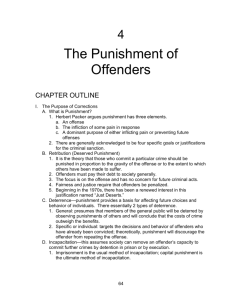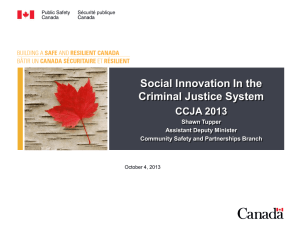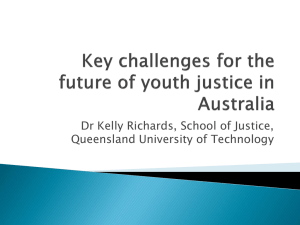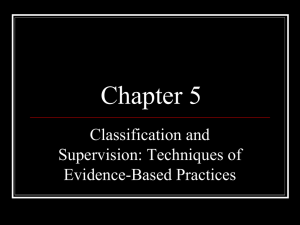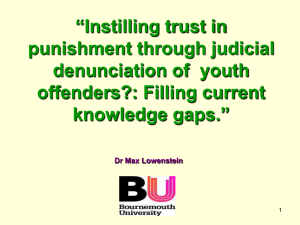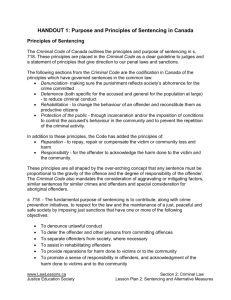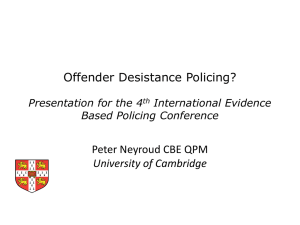DOC - Supreme Court
advertisement
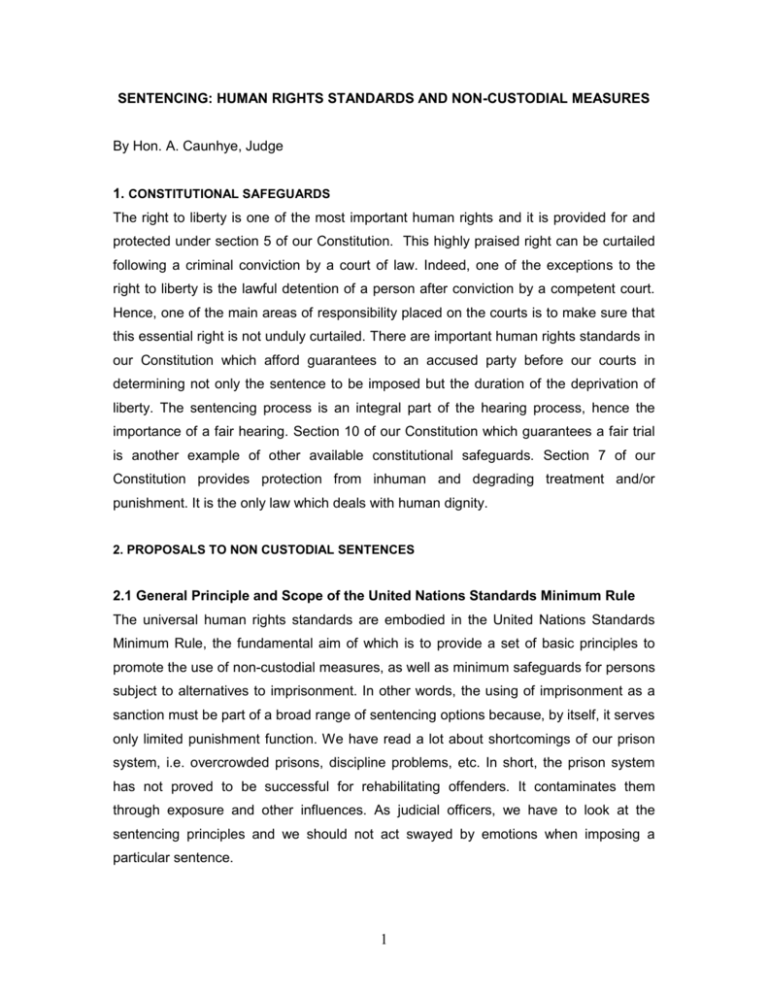
SENTENCING: HUMAN RIGHTS STANDARDS AND NON-CUSTODIAL MEASURES By Hon. A. Caunhye, Judge 1. CONSTITUTIONAL SAFEGUARDS The right to liberty is one of the most important human rights and it is provided for and protected under section 5 of our Constitution. This highly praised right can be curtailed following a criminal conviction by a court of law. Indeed, one of the exceptions to the right to liberty is the lawful detention of a person after conviction by a competent court. Hence, one of the main areas of responsibility placed on the courts is to make sure that this essential right is not unduly curtailed. There are important human rights standards in our Constitution which afford guarantees to an accused party before our courts in determining not only the sentence to be imposed but the duration of the deprivation of liberty. The sentencing process is an integral part of the hearing process, hence the importance of a fair hearing. Section 10 of our Constitution which guarantees a fair trial is another example of other available constitutional safeguards. Section 7 of our Constitution provides protection from inhuman and degrading treatment and/or punishment. It is the only law which deals with human dignity. 2. PROPOSALS TO NON CUSTODIAL SENTENCES 2.1 General Principle and Scope of the United Nations Standards Minimum Rule The universal human rights standards are embodied in the United Nations Standards Minimum Rule, the fundamental aim of which is to provide a set of basic principles to promote the use of non-custodial measures, as well as minimum safeguards for persons subject to alternatives to imprisonment. In other words, the using of imprisonment as a sanction must be part of a broad range of sentencing options because, by itself, it serves only limited punishment function. We have read a lot about shortcomings of our prison system, i.e. overcrowded prisons, discipline problems, etc. In short, the prison system has not proved to be successful for rehabilitating offenders. It contaminates them through exposure and other influences. As judicial officers, we have to look at the sentencing principles and we should not act swayed by emotions when imposing a particular sentence. 1 The United Nations Standard Minimum Rules for Non-custodial measures (The Tokyo Rules), 1990, United Nations Standard Minimum Rules for the Administration of Juvenile Justice (The Beijing Rules), 1985 and the Declaration of Basic Principles of Justice for Victims of Crime and Abuse of Power, 1985 are the relevant legal instruments dealing with the above. The rules are intended to promote greater community involvement in the management of criminal justice, especially in the treatment of offenders, as well as encourage among offenders a sense of responsibility towards society. They shall be implemented taking into account the political, economic, social and cultural conditions of each country and the aims and objectives of its criminal system. When implementing the Rules, Member States shall endeavor to ensure a proper balance between the rights of individual offenders, the rights of victims, and the concern for public safety and crime prevention. The rules also provide that Member States shall develop non-custodial measures within their legal systems to provide other options, thus reducing the use of imprisonment, and to rationalize criminal justice policies, taking into account the observance of human rights, the requirements of social justice and the rehabilitation needs of the offender. The spirit of our Constitution and the way it has been drafted shows that the legislator’s intention was to protect of citizens against undue and excessive practices impinging on their fundamental rights. It shows a defensive mentality. As pointed out by the responsibility of the Member State is not only to comply with human rights provisions by ensuring that no breach is committed but to play a more proactive role. For example in South Africa, creation of institutions and conditions for positive protection of human rights of citizens has been promoted and is embodied in its Constitution. 2.2 Stage of Proceedings and Imposition of Non-Custodial Measures Different considerations need to be had depending on the stage proceedings have reached when non-custodial measures are being contemplated and imposed. At the pre-trial stage, the interest of the offender in seeing the proceedings dismissed has to be weighed against, the protection of society, crime prevention and the promotion 2 of respect for the law and the rights of victims. Dismissal of proceedings is a common non-custodial measure at this stage. At the trial and sentencing stages, recourse to non-custodial measures should consider the rehabilitative needs of the offender, the protection of society, and the interests of the victims, who should be consulted whenever appropriate. As far as the post sentencing stage is concerned, i.e. where a term of imprisonment has already been imposed, our law provides for remission and release on parole under Sections 50 and 51 of the Reforms Institutions Act, respectively. Non-custodial measures imposing an obligation on the offender, applied before or instead of formal proceedings or trial, shall require the offender’s consent and decisions on the imposition of such measures shall be subject to review by a judicial or other competent independent authority, upon application of the offender. 2.3 Sentencing Options The choice of the type of sentence which may be imposed is a judicial function. The commonest type of non-custodial sentences which are imposed by our courts include probation orders, community service orders, conditional or absolute discharge, drug treatments, and metal treatments. The limited application of a community service order, the requirement of the existence of extenuating circumstances in respect of conditional or absolute discharge and its application being usually limited to trivial offences, place difficulties on courts to impose such sentences. Moreover, our law makes no specific provisions for disabled and/or handicapped offenders. In Mauritius, the court will often obtain and consider a pre-sentence report only before imposing a probation or a community service order. Although the law provides that the circumstances relevant to the offence and the offender be taken into account before passing sentence, there is no such provision for a psychological report for instance. Our legal system does not provide and require that the court shall obtain and consider a presentence report before imposing a custodial sentence, i.e. before curtailing the right to liberty of an individual. 3 The following which is not an exhaustive list are examples of different types of noncustodial sentences which may be imposed, the appropriateness of which will depend inter alia on the type of the offence. These include: 1) Curfew order; (2) Exclusion order; (3) Action plan order; (4) Supervision order; (5) Attendance centre order; (6) Reparation order; (7) House arrest; (8) Electronic tagging; (9) Flexible sentence. 3. ALTERNATIVE WAYS AND MEASURES TO EFFECTIVELY DEAL WITH OFFENDERS AND CRIMINAL CASES 3.1. Diversion Diversion can be defined as the channelling of prima facie cases from the formal criminal justice system on certain conditions to extra-judicial programmes, at the discretion of the prosecution. Diversionary options in no way intend to make offenders less accountable or responsible for their actions but rather to provide offenders with the opportunity to rethink their lives without getting a criminal record. A key aspect should be that, in defined circumstances, cases should be diverted away from the criminal justice system as early as possible, either to the welfare system, or to suitable diversion programmes run by competent staff. The aims and purposes of diversion are to encourage the offender to be accountable for the harm caused by him or her, to promote an individualised response to the harm caused which is appropriate to the offender’s circumstances and proportionate to the circumstances surrounding the harm caused, and to promote the re-integration of the offender into society, into the family and the community to provide an opportunity for reparation, to provide an opportunity to the person or persons or community affected by the harm caused to express their views regarding the impact of such crime, to identify underlying problems motivating offending behaviour, to prevent less serious offenders 4 from receiving a criminal record and being labelled as criminals as this may become a self-fulfilling prophecy, to provide educational and rehabilitative programmes for the benefit of all parties concerned, to lessen the case-load of the formal justice system and to prevent stigmatisation which may occur through exposure to the rigours of the criminal justice system. If there are problems with compliance the ultimate sanction that the prosecutor can apply is to re-institute the prosecution and continue with the case through to trial. It is therefore important to explain the rules clearly to the offender and parent/guardian. If it is clear that the offender wilfully neglected to comply with the conditions of the diversion, prosecution remains as the last resort. At pre-trial stage, the law provides that the Director of Public Prosecutions can only go by way of reprimand or caution in deciding not to proceed against an offender. If the DPP is satisfied and there is ample evidence to bring a case to court and establish a conviction, he can have recourse to diversion instead of proceeding with prosecution. The decision to prosecute is suspended provided that the offender undertakes to comply with a diversion programme. The DPP can resort to prosecution in case of non compliance. Diversion is compatible with the constitutional powers of the DPP and will not impeach on the separation of powers because the court will retain the final decision as to whether to accept or reject it. The DPP will operate within a specific line of demarcation, everything will be done with the consent of the accused party and the victim will also come into play. 3.2. Plea Bargaining Plea bargaining will come into play once a case has been lodged and it does not exist in statutory form. It is not a new concept and the uunderlying idea is to dispose of criminal cases without resorting to trials. Plea bargaining permits the prosecuting authority and an accused a party who is legally represented to enter into a plea and sentence agreement. The court may not participate in the negotiations, but is required to approve the plea and sentence, before making it an order of the court. The main principles, rules and features of plea bargaining include inter alia that the negotiations are non-prescriptive, i.e. it is left to the defense to initiate the process and 5 find common ground as far as possible for the purposes of plea and sentence which they can present to the court and the prosecutor retains his discretion to accept the proposal. The parties are required to present the court with a well considered agreement, consisting of both a plea and a sentence. This agreement should set out all the substantial facts of the case, all relevant facts relevant to sentence and any admissions made by the accused. At a specific stage, the contents of the plea and sentence agreement are disclosed to an open court, unless ordered in camera by the court itself. Although the court does not participate in the negotiation process, judicial approval is required to endorse the outcome of the negotiations. The court retains the duty to assess the guilt of the accused and the court remains the final arbitrator of what an appropriate sentence is. The prosecutor or the defence may withdraw from a plea agreement if the court does not accept the sentence agreement. 3.2.1. Advantages of Plea Bargaining Lawyers have to contend with overloaded court rolls as well as the backlogs in the huge number of prisoners awaiting trial results in overcrowded prisons reaching crisis proportions. It is a method of easing those problems and at the same time complies with the constitutional obligation of a speedy trial. There are clear advantages of offering the parties especially in serious fraud cases the opportunity to consider reaching a court sanctioned agreement at a much earlier stage than hitherto. These relate to the large financial savings to the public purse that can be made by early disposal of these cases and easing the strain caused by delay on defendants, victims and witnesses. In some cases it would also give the investigators and prosecuting authorities more information at an early stage to allow a more focused and efficient investigation into the role of others involved in the criminality and with whom no such an agreement is reached. Advantages to the offender include the fact that cases will be finalised swiftly and lead to reduced costs, uncertainties of trial will be avoided, conviction may be on a lesser charge, hence a reduced sentence. The State on the other hand will benefit from a greater flexibility in disposing of criminal trials. Protracted and costly trials will be avoided, overloading of court rolls will be minimized, burden on resources reduced, uncertainties of trial will be averted, so will the trauma of trial for a complainant who will gain an immediate sense of closure. 6 3.3. Out of Court Settlement A process to settle cases out of court will have particular advantage for the criminal justice process. Such a process will, among others not only contribute to saving precious court time and costs, since cases can be finalized without going to court, and without the time consuming task of settling factual disputes but will improve the public’s perception of the administration of justice. The accused person will have the opportunity not to end up with a record of previous convictions, a factor which often prompts people to dispute criminal charges. If all parties involved approach the matter with open minds, it will provide ample opportunity for the application of restorative justice initiatives as an outcome of an out-of-court settlement. Victims will be protected from publicity and from having to be subjected to cross-examination, and yet benefit from compensation or restitution by the accused. Conclusion The above strategies must be developed in concert with other stakeholders and criminal justice agencies and must be developed both at the upfront (before admission) and further downstream (early release options) of the sentence. The process of developing and implementing solutions would be neither straightforward nor brief since many of the current sentencing practices and the attitudes towards sentencing reflect deeply held cultural and societal beliefs. Efforts should be carried out simultaneously on several fronts if the prison population (both daily counts and admissions) is going to be reduced. This should include amending or adopting legislation to ensure not only the implementation of diversion, outof-court settlements, plea bargaining and relevant procedures but ensure that all sentencing options are considered for all offenders and that imprisonment is used only as a last resort and when all other sentences are deemed inappropriate. There were suggestions that the French system be followed when sentencing an offender, in respect of obtaining reports on the latter given that the court does not know much of the offender when sentencing him/her. It was also suggested that victims be called at the time of sentencing and that may be the exercise of sentencing should be left to the jury! 7


